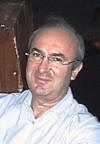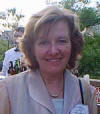
When I was PVA’s research director in the 1990s, a
physical therapist excitedly told me how one of her patients with
quadriplegia had regained impressive function after laser therapy (LT).
She asked for my advice in moving her approach forward. Although I tried
to be helpful, her paradigm-expanding, energy-based methodology just
didn’t fit into the prevailing thinking of the drug-emphasizing,
biomedical establishment. Although the establishment supports
meritorious approaches, it was not designed for quantum-leap innovations
generated by outsiders. Because I now believe LT can exert substantial
neuroregenerative influences, I regret I wasn’t more proactive.
Lasers
Basically, lasers amplify light by producing
coherent light beams. Because low-energy lasers represent a
noninvasive, non-heat-producing, painless mechanism to stimulate
regenerative processes, they are finding numerous therapeutic
applications. Laser energy affects many physiological processes,
including cellular respiration and gene expression.
Intriguing research documents LT’s potential to
treat various neurological injuries and insults, including
peripheral-nerve, spinal-cord, and head injuries; and stroke. For
example, research shows that laser irradiation induces sprouting and
outgrowth of neurites (e.g., budding axons and dendrites), and
stimulates the production of nerve growth factors.
Of special interest for SCI is LT’s enhancement of
functional recovery after stem-cell transplantation. Many SCI-focused
transplantation programs are emerging throughout the world, and
successful outcomes seem to be dependent on a host of factors; LT may be
one of them.
Spinal-Cord &
Peripheral Nerve Injuries
1) Israel’s Dr. Shimon Rochkind believes
that LT is best used to augment cell transplantation. For example,
Rochkind’s team examined the effects of combining the implantation of
embryonic spinal-cord cells with LT on recovery after SCI in rats.
Results indicated that the best recovery of limb function and gait
performance, nerve-signal conduction, and tissue growth occurred when
cell implantation was combined with laser irradiation; i.e., each
therapy by itself was less effective.

In another study, Rochkind evaluated the effects of
laser irradiation on axonal regeneration across a transected
peripheral nerve bridged with a biodegradable polymer. Such polymers
may ultimately play an important role in SCI by paving over the pothole
laden injury pathway to make it more regeneration friendly. Briefly,
rats were irradiated at both the reconstructed peripheral injury
location and the corresponding spinal-cord sections. Compared to
controls, laser-treated rats had more myelinated (i.e. insulated) axons
going across the polymer bridge, signal conduction, and functional
recovery.
In another study, Rochkind evaluated LT’s
effectiveness in patients with incomplete peripheral-nerve or
brachial-plexus-nerve injuries (nerve network
that conducts signals from the spine to the arms). Specifically, 18
subjects, injured at least six months earlier, were randomly assigned to
receive either transcutaneous laser irradiation or treatment from an
identical looking placebo device. Subjects were treated for 21
consecutive days at the injury site and corresponding spinal-cord
segments. Compared to controls, the laser-irradiated subjects improved
in motor function.
2) Drs. Kimberly Byrnes, Juanita Anders
(photo) and colleagues (Bethesda, MD) have shown that laser i rradiation
alters gene expression in rats after acute SCI and exerts an
anti-inflammatory effect on the injured cord. These influences reduces
secondary injury and, in turn, some of the barriers inhibiting axonal
regeneration.
rradiation
alters gene expression in rats after acute SCI and exerts an
anti-inflammatory effect on the injured cord. These influences reduces
secondary injury and, in turn, some of the barriers inhibiting axonal
regeneration.
Especially relevant to the promising
olfactory-tissue-transplantation
procedures discussed elsewhere, the investigators showed that laser
irradiation alters gene expression of the regeneratively-endowed
olfactory ensheathing cells (OECs). This alteration enhances the
expression of key growth factors and extracellular-matrix proteins that
support neuronal regeneration. The findings support LT’s use in
combination with OEC transplantation.
In a recent article, Dr. Anders et al compared the
effects of LT in rats with injuries created by either 1) cutting a
portion of the cord (i.e., hemisection) or 2) an impact-caused contusion
(most common sort of injury). Immediately after injury, rats were
irradiated through the skin at the injury site for 14 consecutive days.
Compared to controls, LT augmented axonal survival and re-growth, and
functional recovery for both injury types.
3) France’s Albert Bohbot has developed a
real-world program that combines LT with acupuncture, another therapy
with function-restoring potential (www.laserponcture.eu).
Although laser stimulation of acupuncture points is not new, Bohbot has
refined the technology with a focus on treating a variety of
neurological disorders, including SCI.

Key to his therapy is a network of acupuncture
points that relate meridians (through which acupuncture’s life-force qi
energy flows) to dermatome levels (i.e., a region of skin sensation that
corresponds to a specific spinal-cord area). Bohbot believes energy
stimulation through this network promotes functional recovery.
He has treated numerous people with chronic SCI,
many of which have regained impressive function. Bohbot’s patients
include those who have been recipients of transplanted regeneratively
endowed cells or tissue, including OECs, patient-derived olfactory
tissue, and bone-marrow-derived stem cells. (see resources below)
Stroke
Evidence indicates that LT improves outcomes after
ischemic stroke (neurological damage caused by interruption of brain’s
blood flow). For example, in an international, multicenter clinical
trial, 120 patients were randomized to receive transcranial LT (i.e.,
through the skull) or treatment from a sham device within 24 hours of
stroke onset. After 90 days, 70% of the LT subjects had improvements
compared to only 51% of the controls.
In a recent, even larger study, 660 patients with
acute ischemic stroke were randomized to receive either transcranial LT
or sham treatment. In the LT group, 120 achieved a favorable outcome
compared to 101 controls.
Head Injury
Dr. A. Oron and colleagues (Israel) have
shown that transcranial LT reduces head injury in rats when administered
four hours after trauma. In an anecdotal case, a university teacher
improved cognitive function after starting transcranial LT seven years
after a head injury from an auto accident. Specifically, her ability to
focus attention on her computer improved from ~20 minutes to three
hours. However, she regresses if treatment is not maintained.
Conclusion
Ralph Waldo Emerson said “build a better mousetrap,
and the world will beat a path to your door.” Perhaps for many things -
but when it comes to new therapies, it is more apropos to say the world
may limp to your door sometime in the distant future. Preferring the
status quo, the biomedical establishment is slow to embrace much needed
innovation. Innovators are routinely slapped down and must pass through
a daunting professional gauntlet to advance their ideas. This, indeed,
has been the case for some of laser therapy’s pioneers. Fortunately, a
critical mass of new thinking has now percolated into the scientific
community’s collective consciousness - making it more difficult to
dismiss the therapy’s neuroregenerative potential.
Adapted from Paraplegia News, June 2009
(For subscriptions, contact www.pn-magazine.com).